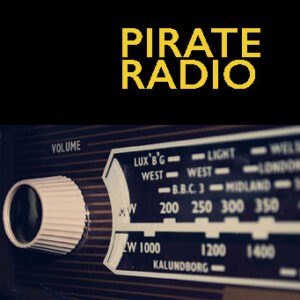The British pop boom of the early sixties was fueled by what was called at the time- Pirate Radio.

At the time the BBC had only four radio channels which catered to approximately four tastes in music. The Third and Fourth programs were serious classical and dramas. The other two were more mainstream and The Light Program aired the closest to what might be called pop music. One needed a license to listen (which to be fair paid for non commerciality). The Beeb employed live musicians for a large part of their output and “needle time” was minimal. In fact for any artist to be heard they had to be members of the Musicians Union. Also the channels were all closed down by midnight.
The BBC was not ready for the baby boomers who arrived as teenagers in the early sixties. The output of music aimed at these teenagers increased exponentially and Auntie BBC could not keep up with the volume and demand for the new popular music. Radio Luxembourg filled in with lots of needle time but only between about 6 pm and 1 am and it was loaded with static fading in and out on its journey from middle Europe to the ears glued to tiny (and tinny) transistor radios.
Into the void steps Pirate Radio. First Radio Caroline then followed by Radio London, then a slew of smaller stations popped up on rusty old hills or on concrete forts left over from WW2 . Unless one was right on the south coast of England it came in crackling with static. The stations were set up by entrepreneurs to meet the growing demand for pop and rock music, which was not catered for by the BBC
By 1967, ten pirate radio stations were broadcasting to an estimated daily audience of 10-15 million. Influential pirate radio DJs included John Peel, Tony Blackburn, Kenny Everett, Johnnie Walker, Tony Prince, Emperor Rosko and Spangles Muldoon.
The format of this wave of pirate radio was influenced by American radio stations. Many followed a top-40 format the antithesis of BBC radio at the time. As many of the djs were American the listeners got to hear many records not even released in the UK and thus worked upon a demand for these songs to be officially released. Also a dj was required to play 2 or three songs from the top 50 but then could fill in with another two or three songs of their own choosing which gave a musical education to those listening. One could hear jazz between the big hits.
Radio London stopped broadcasting at midnight when the daytime jocks retired for the night. By 1966 to 1967 there was a new demand in music from the flowers powered psychedelic crowd. and into the late night fray stepped John Peel and The Perfumed Garden. (https://auralfixations.allanstephenson.com/?p=202)
In reaction to the popularity of pirate radio the BBC radio was restructured in 1967, establishing BBC Radio 1, Radio 2, Radio 3 and Radio 4. The UK Government also closed the international waters loophole via the Marine Broadcasting Offences Act of 1967 making it illegal for any British company to advertise on these stations. Radio London closed in August of 1967 but Radio Caroline would continue to broadcast in various forms in various mediums right up to 1990.
A number of DJs of the newly formed Radio 1 came from these pirate stations including John Peel who then went on to greater heights with the BBC as taste maker and a maven for the next wave of music such as Punk.
For a documentary about perhaps the best of these stations Radio London here.
_____________________________________
When I left England in 1971 FM stereo radio was still in experimental mode. (Listen to an example here).
A good radio in Britain (and in Europe) had three wavebands- Long wave or VHF-FM), medium wave (AM) and short wave. The latter carried long distance but at very low quality. Long wave had great quality but did not travel far. Medium wave was a compromise between the two. There was also short wave which was very static laden but one could pull out very far away stations in the world.

In Britain the BBC broadcast on all those wavelenghs and was easily picked up anywhere in the country. However the output of music became increasingly limited as the sixties came and could not keep up with the volume of demand for popular music.
